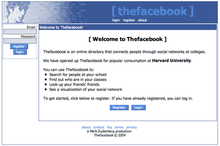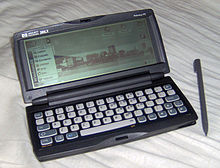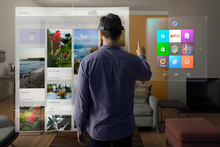The founders had initially limited the website's membership to Harvard students; however, later they expanded it to
higher education institutions in the Boston area, the
Ivy League schools, and
Stanford University. Facebook gradually added support for students at various other universities, and eventually to high school students as well. Since 2006, anyone age 13 and older has been allowed to become a registered user of Facebook, though variations exist in the minimum age requirement, depending on applicable local laws.
[9] The Facebook name comes from the
face book directories often given to United States university students.
[10]
Facebook may be accessed by a large range of
desktops,
laptops,
tablet computers, and
smartphones over the
Internet and
mobile networks. After registering to use the site, users can create a
user profile indicating their name, occupation, schools attended and so on. Users can add other users as
"friends", exchange messages, post status updates and
digital photos, share digital videos and links, use various
software applications ("apps"), and receive notifications when others update their profiles or make posts. Additionally, users may join common-interest user groups organized by workplace, school, hobbies or other topics, and categorize their friends into lists such as "People From Work" or "Close Friends". In groups, editors can pin posts to top. Additionally, users can complain about or block unpleasant people. Because of the large volume of data that users submit to the service, Facebook has come under scrutiny for its privacy policies. Facebook makes most of its revenue from
advertisements which appear onscreen.
Facebook, Inc. held its
initial public offering (IPO) in February 2012, and began selling
stock to the public three months later, reaching an original peak
market capitalization of $104 billion. On July 13, 2015, Facebook became the fastest company in the
Standard & Poor's 500 Index to reach a market cap of $250 billion.
[11] Facebook has more than
1.86 billion monthly active users as of December 31, 2016.
[12] As of April 2016, Facebook was the most popular social networking site in the world, based on the number of active user accounts.
[13] Facebook classifies users from the ages of 13 to 18 as minors and therefore sets their profiles to share content with friends only.
[14]
2003–06: Thefacebook, Thiel investment, and name change
Zuckerberg wrote a program called "Facemash" on October 28, 2003 while attending
Harvard University as a
sophomore (second year student). According to
The Harvard Crimson, the site was comparable to
Hot or Not and used "photos compiled from the online facebooks of nine houses, placing two next to each other at a time and asking users to choose the 'hotter' person".
[15][16][17]
To accomplish this, Zuckerberg
hacked into protected areas of Harvard's computer network and copied private dormitory
ID images. Harvard did not have a student "
face book" (a directory with photos and basic information) at the time, although individual houses had been issuing their own paper facebooks since the mid-1980s, and Harvard's longtime Freshman Yearbook was colloquially referred to as the "Freshman Facebook". Facemash attracted 450 visitors and 22,000 photo-views in its first four hours online.
[15][18]
The site was quickly forwarded to several campus group list-servers, but was shut down a few days later by the Harvard administration. Zuckerberg faced expulsion and was charged by the administration with breach of security, violating
copyrights, and violating individual privacy. Ultimately, the charges were dropped.
[19] Zuckerberg expanded on this initial project that semester by creating a social study tool ahead of an
art history final exam. He uploaded 500
Augustan images to a website, each of which was featured with a corresponding comments section.
[18] He shared the site with his classmates, and people started sharing notes.

Original layout and name of Thefacebook, 2004.
The following semester, Zuckerberg began writing code for a new website in January 2004. He said that he was inspired by an editorial about the Facemash incident in
The Harvard Crimson.
[20] On February 4, 2004, Zuckerberg launched "Thefacebook", originally located at thefacebook.com.
[21]
Six days after the site launched, Harvard seniors
Cameron Winklevoss,
Tyler Winklevoss, and
Divya Narendra accused Zuckerberg of intentionally misleading them into believing that he would help them build a social network called
HarvardConnection.com. They claimed that he was instead using their ideas to build a competing product.
[22] The three complained to
The Harvard Crimson and the newspaper began an investigation. They later filed a lawsuit against Zuckerberg, subsequently settling in 2008
[23] for 1.2 million
shares (worth $300 million at Facebook's
IPO).
[24]
Membership was initially restricted to students of
Harvard College; within the first month, more than half the undergraduates at Harvard were registered on the service.
[25] Eduardo Saverin (business aspects), Dustin Moskovitz (programmer),
Andrew McCollum (graphic artist), and
Chris Hughes joined Zuckerberg to help promote the website. In March 2004, Facebook expanded to the universities of
Columbia,
Stanford, and
Yale.
[26] It later opened to all
Ivy League colleges,
Boston University,
New York University,
MIT, and gradually most universities in the United States and Canada.
[27][28]
In mid-2004, entrepreneur
Sean Parker—an informal advisor to Zuckerberg—became the company's president.
[29] In June 2004, Facebook moved its operations base to
Palo Alto, California.
[26] It received its first investment later that month from
PayPal co-founder
Peter Thiel.
[30] In 2005, the company dropped "the" from its name after purchasing the
domain name facebook.com for
US$200,000.
[31] The domain facebook.com belonged to AboutFace Corporation before the purchase. This website last appeared on April 8, 2005;
[32] from April 10, 2005 to August 4, 2005, this domain gave a 403 error.
[33]
In May 2005,
Accel Partners invested $12.7 million in Facebook, and
Jim Breyer[34] added $1 million of his own money. A high-school version of the site was launched in September 2005, which Zuckerberg called the next logical step.
[35] (At the time, high-school networks required an invitation to join.)
[36] Facebook also expanded membership eligibility to employees of several companies, including
Apple Inc. and Microsoft.
[37]
2006–2012: public access, Microsoft alliance and rapid growth
In late 2007, Facebook had 100,000 business pages (pages which allowed companies to promote themselves and attract customers). These started as group pages, but a new concept called company pages was planned.
[41]Pages began rolling out for businesses in May 2009.
[42]
On October 24, 2007, Microsoft announced that it had purchased a 1.6% share of Facebook for $240 million, giving Facebook a total implied value of around $15 billion.
[43] Microsoft's purchase included rights to place international advertisements on the social networking site.
[44]
In October 2008, Facebook announced that it would set up its international headquarters in
Dublin, Ireland.
[45] Almost a year later, in September 2009, Facebook said that it had turned cash-flow positive for the first time.
[46]
A January 2009
Compete.com study ranked Facebook the most used social networking service by worldwide
monthly active users.
[47] Entertainment Weekly included the site on its end-of-the-decade "best-of" list saying, "How on earth did we stalk our exes, remember our co-workers' birthdays, bug our friends, and play a rousing game of
Scrabulous before Facebook?"
[48]
Traffic to Facebook increased steadily after 2009. The company announced 500 million users in July 2010
[49] making it the largest online social network in the world at the time. According to the company's data, half of the site's membership use Facebook daily, for an average of 34 minutes, while 150 million users access the site by mobile. A company representative called the milestone a "quiet revolution."
[50]
In November 2010, based on
SecondMarket Inc. (an exchange for privately held companies' shares), Facebook's value was $41 billion. The company had slightly surpassed
eBay to become the third largest American web company after
Google and
Amazon.com.
[51]
In early 2011, Facebook announced plans to move its headquarters to the former
Sun Microsystems campus in Menlo Park, California.
[52][53] In March 2011, it was reported that Facebook was removing approximately 20,000 profiles offline every day for violations such as spam, graphic content, and underage use, as part of its efforts to boost
cyber security.
[54]
Release of statistics by
DoubleClick showed that Facebook reached one trillion
page views in the month of June 2011, making it the most visited website tracked by DoubleClick.
[55] According to a Nielsen Media Research study, released in December 2011, Facebook had become the second-most accessed website in the U.S. behind Google.
[56]












